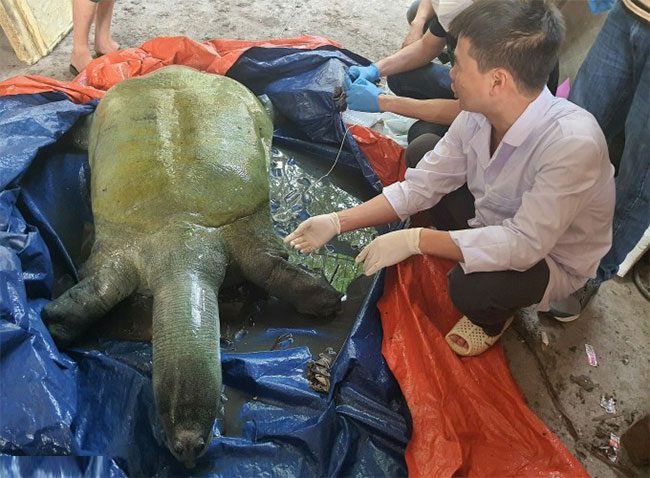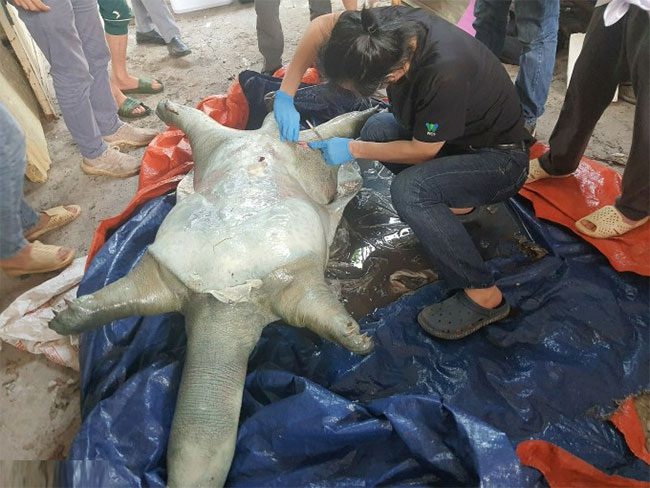The Rafetus swinhoei turtle (Hoan Kiem turtle) will be preserved in a deep-freeze room at -20 degrees Celsius while awaiting a handling plan from the Hanoi People’s Committee.
This information was shared by Associate Professor Dr. Phan Kế Long, Chairman of the Scientific Council at the Vietnam Natural Museum, in an interview with a reporter.

The turtle’s body was transferred to the Vietnam Natural Museum on the afternoon of April 24. (Photo: Võ Hải)
The Hoan Kiem turtle in Dong Mo Lake, measuring 1.56m in length and weighing 93kg, was confirmed dead on the morning of April 23. On the afternoon of April 24, the turtle specimen was handed over to the museum for preservation. The deep-freeze environment is the best for preserving the turtle’s body for use in crafting or DNA research in the future.
Experts have collected 15 samples for research to determine the species, age, and cause of death. While waiting for the DNA results to confirm, Mr. Long stated that based on the morphology, this is a Rafetus swinhoei turtle (also known as the Hoan Kiem turtle).

Experts are collecting samples for research. (Photo: Võ Hải)
Based on experience with the Hoan Kiem turtle specimen that died in January 2016, the leaders of the Natural Museum proposed that the turtle’s body be processed into a taxidermy specimen. Currently, there are several preservation methods such as wet preservation or plastination. However, if wet preservation is used, displaying it requires immersion in solvents, which could lead to combustion, while soaking in alcohol or formaldehyde will not maintain the aesthetic and will cause discoloration. “The plastination method is the most optimal for this species, which lacks fins and scales,” Professor Long said.
The plastination method has been successfully applied to the Hoan Kiem turtle. Once completed, the Hoan Kiem turtle specimen measures over 2m in length and 1.1m in width. “The taxidermy specimen of the Hoan Kiem turtle was handed over to the display house of Ngọc Sơn Temple, looking as lifelike as possible and retaining longevity,” Mr. Long added.
This is the most modern method in the world, preserving the specimen’s original state in terms of morphology, color, and even delicate parts like the eyes and carapace. Water and fat dissolved in the cells will be completely removed and replaced with a special resin. As the resin enters the body, it permeates through the cells, helping to maintain the structure. This method also preserves the specimen (including bones and cartilage) as closely as possible to a living specimen, leaving no odor and providing high durability.
The plastination technique for preserving corpses and animal specimens was invented by German scientist Gunther Von Hagens in 1977. In this technique, technicians remove water and fat from the animal’s body and replace it with plastic. The plastination technique also includes using resin to preserve organs and complex vascular systems within the body, followed by using acid to break down the surrounding cells and structures.
The Hoan Kiem turtle (also known as Swinhoe’s turtle, Rafetus swinhoei) was first described in 1873, but there has been very little research on this giant soft-shell turtle species. Currently, there are only four Hoan Kiem turtles left, two in China, one in Dong Mo Lake, and one in Xuan Khanh Lake (Son Tay, Hanoi). The only Rafetus Swinhoei turtle living in Hoan Kiem Lake died in January 2016.
The Hoan Kiem turtle in Dong Mo Lake was first discovered by conservationists from the Asian Turtle Conservation Program in 2007. A year later, during a historic flood in Hanoi, it escaped from the lake and was captured by fishermen. Thanks to the efforts of authorities and conservationists, the turtle was returned to the lake and has been monitored since then.


















































